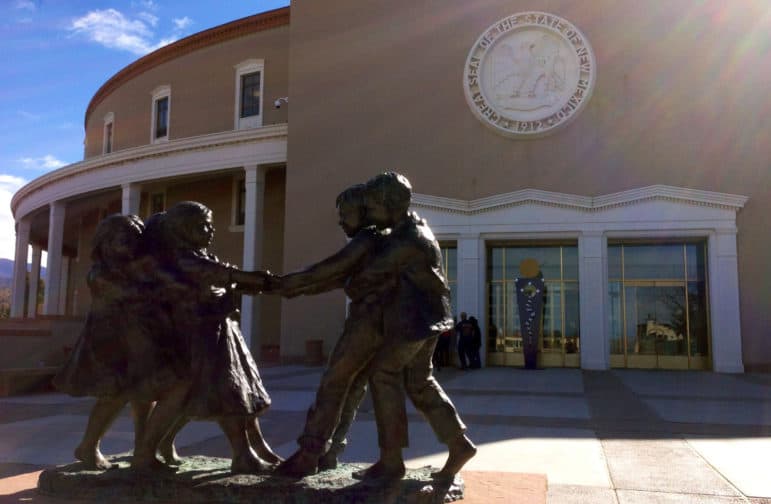
Heath Haussamen / NMPolitics.net
A larger unknown is what will happen when lawmakers convene in January 2017 to craft a budget for 2018. “There is no fat left, there’s no lard left, there is nothing but bone left. So, if the economy doesn’t turn around, we have more unpleasant work left,” said Sen. Gerald Ortiz y Pino.
State lawmakers on Wednesday agreed to a 2017 spending plan, but only after approving a measure to tap into millions of unspent dollars from dozens of state accounts to offset lower projected revenues.
The $6.2 billion budget for fiscal year 2017 — the same spending level as 2009 — cuts about 2 percent of spending from most state agencies, with higher reductions for community colleges and universities.
The state will spend $2.75 billion for public education starting July 1, an increase of about $7 million, which includes a $2,000-a-year annual raise for Level 2 and Level 3 teachers. Teachers also could qualify for a share of another $6 million in merit pay distributed statewide by the Public Education Department.
Spending on Medicaid in New Mexico would reach $928 million, but that would not be enough to support current services for the 800,000 patients in the program. As a result, the state will likely be cutting reimbursement rates to hospitals, doctors and social workers, as well as increase copays for those patients in the government insurance program.
Some agencies, including the departments of Corrections and Public Safety, as well as the courts, prosecutors and Office of Public Defender, would receive modest increases to pay for salary hikes and higher caseloads.
The patchwork budget was a moving target during the 2016 session as revenue estimates continued to crater by the week. House lawmakers spent some two hours Wednesday debating the one-time fixes needed to bring it into balance. In the end, members voted 57-10 to agree with Senate amendments that trimmed back an earlier House proposal, and sent the measure on to Gov. Susana Martinez.
But that doesn’t mean anyone is happy.
“This is not something we wanted to do, it’s something we had to do,” Sen. William Burt, R-Alamogordo, said Wednesday on the Senate floor about using $129.5 million in unspent money to pay for basic services, such as education and public safety. “No one on the House side or the Senate side is happy to have to do this.”
“We had a deficit in revenues,” said state Rep. Jimmie Hall, R-Albuquerque. “That is the reason we had to do the sweeps to balance the budget.”
House Democrats were more frustrated, saying some of their proposals to increase taxes were not even given a debate, as Republican Gov. Martinez promised to balance spending without raising revenue.
“What we’ve done, unfortunately, is double down on borrowed money to pay for the state operating expenses,” said Rep. Brian Egolf, a Santa Fe Democrat who serves as the House minority leader. “It’s almost the opposite of hard work. It is an easy solution to a problem we have seen coming for some time.”
Initial budgets for state agencies were set in December, when the price of crude oil was higher and overall revenue projections showed more than $200 million in new money was expected for 2017.
In Gov. Martinez’s State of the State speech, she told lawmakers, “Working together, we have put state government on firm fiscal ground, balancing our budget each year without raising taxes. We’ve restrained government growth and built up a strong savings account.”
But within a week, lawmakers realized the budget-writing committee would have to tap into much of that savings account to sustain everyday services.
The general fund reserve balance stood at $713 million on June 30, 2015 — 11.6 percent of the budget. But the decline in oil prices has whacked more than $300 million from revenues. If the revenue stream stabilizes for the state, reserves are expected to be $340 million at the end of June 2016 — 5.4 percent of the spending.
As it is, the budget not only sweeps money from the unspent funds but also transfers all of the money from a Tax Stabilization account into more liquid operating reserves and moves money from a tobacco settlement fund into the state Medicaid program.
Gov. Martinez also would have the authority to take more money from reserves, and one source of that would be money set aside in the state Economic Development Department to help businesses expand or relocate to New Mexico.
During the House debate, Rep. Patricia Lundstrom, D-Gallup, asked House Budget Chairman Larry Larrañaga, R-Albuquerque, how much reserves will drop if the state’s cash flow doesn’t get better.
“Operating reserves would be down to zero,” Larrañaga said.
The spending reductions, however, could have been a lot worse, if not for the unspent cash balances in various state accounts.
In a discussion about the sweeps on the Senate floor, Sen. Howie Morales, D- Silver City, said using $4 million that would have gone to local DWI programs or $1 million to finance water project loans seems to go against what lawmakers have been trying to accomplish in the 30-day session.
“Are we contradicting whatever efforts have been made during this session?” Morales asked.
A larger unknown is what will happen when lawmakers convene in January 2017 to craft a budget for 2018.
“These are painful times,” said Sen. Gerald Ortiz y Pino, D-Albuquerque. “I appreciate the work trying to find some money. This gets us through this year and the budget we’re working on. There is no fat left, there’s no lard left, there is nothing but bone left. So, if the economy doesn’t turn around, we have more unpleasant work left.”
Contact Bruce Krasnow at brucek@sfnewmexican.com.